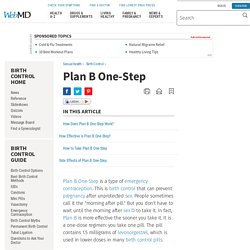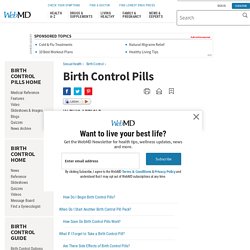

Natural Family Planning - familydoctor.org. Natural Family Planning What is natural family planning?

Natural family planning is a method used to help a couple determine when sexual intercourse can and cannot result in pregnancy. During the menstrual cycle, a number of changes occur in a woman’s body. By keeping track of these changes, couples can plan when to have intercourse and when to avoid intercourse, depending on whether they are trying to achieve or avoid pregnancy. During each menstrual cycle, one of a woman’s ovaries releases an egg. How does natural family planning work? Two methods of natural family planning are currently taught. Plan B (Morning-After Pill): Effectiveness and Side Effects. Plan B One-Step is a type of emergency contraception.

This is birth control that can prevent pregnancy after unprotected sex. People sometimes call it the "morning after pill. " But you don't have to wait until the morning after sex to take it. In fact, Plan B is more effective the sooner you take it. Permanent Birth Control: Essure, Tubal Ligation and Vasectomy. NuvaRing: Effectiveness, Side Effects, Warnings, for the Birth Control Ring.
The NuvaRing is a birth control option for women.

It’s a small, flexible contraceptive ring, about the size of a silver dollar. How Does It Work? The NuvaRing contains the same hormones as many birth control pills. Birth Control Patch: Ortho Evra Side Effects and Effectiveness. This tiny skin patch has the same hormones as those in many birth control pills.

Women can wear it on their buttocks, belly, chest (except for the breasts), or the outer part of the upper arm. Birth Control Patch: Ortho Evra Side Effects and Effectiveness. How to Use Condoms: Effectiveness for Birth Control and Protection from STDs. Condoms prevent pregnancies and STDs.

They create a barrier that keeps semen and other body fluids out of the vagina, rectum, or the mouth. There are condoms for men and for women -- but don't use both at the same time. One can stick to the other and pull it out of place or tear it. What Is a Male Condom? It's a fitted, thin plastic cover that a man wears on his penis during sex. Intrauterine Device (IUD) Birth Control and Side Effects. How Effective is the Contraceptive Vaginal Sponge as Birth Control? Diaphragms for Birth Control: Use, Benefits, and More. Women have been using the diaphragm for birth control in one form or another for hundreds of years.

It’s a small, flexible cup made of silicone or latex that goes inside the vagina to block sperm from reaching an egg. It has very few risks and can be up to 94% effective. Here’s how to decide if it’s right for you. How do you use a diaphragm? You need to use a diaphragm along with a cream or gel that kills sperm, called a spermicide. First squeeze about a tablespoon of spermicide inside the cup of the diaphragm and spread more around the rim. Get in a comfortable position with your legs open and knees bent. You can put it in up to 6 hours before you have sex, and you need to leave it in for at least 6 hours after. Once it’s in place, you can have sex more than once, but you need to reapply spermicide before each time. Birth Control Pill: Side Effects, Effectiveness, How the Pill Works, and Types.
Birth control is a way for men and women to prevent pregnancy.

There are many different methods of birth control, including hormonal contraception such as "the pill. " Women take the pill by mouth to prevent pregnancy, and, when taken correctly, it is up to 99.9% effective. However, the pill does not protect against sexually transmitted diseases, including HIV (the virus that causes AIDS). The latex male condom provides the best protection from most STDs. Other types of combined estrogen and progestin hormonal contraception include the patch and the vaginal ring.
How Does Hormonal Contraception Work? A woman becomes pregnant when an egg released from her ovary (the organ that holds her eggs) is fertilized by a man's sperm.
Nebraska - AIDSVu. Common Types of STDs: Statistics by State - NerdWallet. People don’t often discuss sexually transmitted diseases openly, so their prevalence is not widely known.

However, when it comes to certain STDs, that information is available. An estimated 20 million infections are sexually transmitted each year in the United States, many of which are never reported or treated, according to the Centers for Disease Control and Prevention. Sexually transmitted diseases account for about $16 billion annually in health care costs, according to the CDC. The Prevalence of STDs The three most common sexually transmitted diseases reported to the CDC are chlamydia, gonorrhea and syphilis. That tells part of the picture, but incidence rates of STDs vary widely by state. STD Prevalence by state All STD rate data are 2013 figures obtained from the CDC; this page has been updated to reflect the most current statistics. Gloved hands photo courtesy of Shutterstock.
Hidden STD Epidemic: Maps Show Infection Rates in 50 States. Infectious diseases seem to come and go, sometimes causing scary outbreaks, while other times seeming to disappear.

But some infectious pathogens are always with us, lurking just below the surface of society. Sexually transmitted diseases are one major group of diseases that make for ongoing hidden epidemics: In the United States alone, there are nearly 20 million cases of new sexually transmitted infections yearly, from just eight viruses and bacteria, according to data from the Centers for Disease Control and Prevention (CDC). These are the estimates of the number of people with new and existing cases of eight STDs in the United States. The estimates are based on 2008 data.Credit: Satterwhite CL, et al. Harvard Med Students Hilariously Ask 'What Does the Spleen Do?'